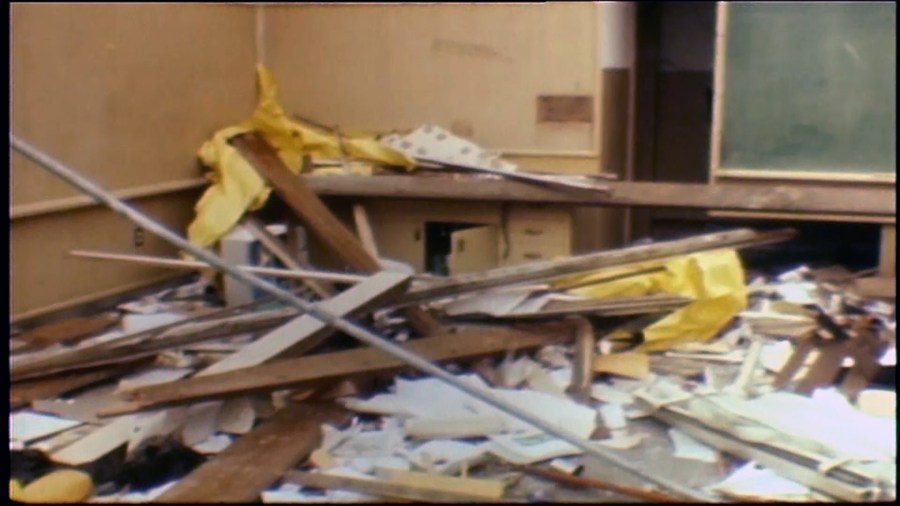PORTLAND, Ore. (KOIN) – April 5, 1972 started out as a sunny, early-spring day, according to Cindy Stanley, who was in ninth grade in the Evergreen School District at the time. But that afternoon, the sky grew dark and the weather took an extreme turn.
Someone walked into her classroom and said a tornado was coming.
“You’re envisioning the end of the world as you know it,” Stanley recounted. “You’re thinking about your family, your horses, dogs, your siblings, anybody that you cared about, you’re wondering what happened to them.”
As the deadly EF3 carved its way through Vancouver, Stanley and her classmates at the Covington Cascade Junior High School took shelter against a classroom wall.
One of her teachers was from Kansas and had experience with tornadoes. She told the students to cover their heads with binders or books.
“You’re envisioning the end of the world as you know it.”
Cindy Stanley – 9th Grader in 1972
At the time, students carried transistor radios with them to school and many were listening closely to what was going on outside.
“It sounded like it was ‘War of the Worlds’ out there,” Stanley said. “Getting media and getting these fantastic reports from things that are happening just tended to freak us out even more.”
Stanley didn’t see much damage on the bus ride home that day, but after school her parents took her and her sister on a drive to Mill Plain where they could see the devastation.
One house would be completely destroyed and the one next to it would be perfectly fine, Stanley remembered. The damage was sporadic and inconsistent. Stanley witnessed the Columbus Day Storm when she was a young girl and said the ruin that resulted from the tornado was much different.
She saw damage to a golf driving range along Mill Plain Boulevard, the nearby shopping center, Peter S. Ogden Elementary School, and the bowling alley. The elementary school and bowling alley were completely destroyed in the natural disaster.

None of Stanley’s family members or close friends died or were seriously injured in the storm, but she heard stories of other people who lost their lives. One woman, she said, died after holding up the wall of the daycare alley at the bowling alley. She held it up so the kids could escape, but died when she couldn’t support its weight any longer.
“Even as a normal 15-year-old, normal ninth grader, I couldn’t sleep with the lights off for about two weeks,” she said. “I wasn’t even directly affected. I was just in it.”
She said the tornado still affects her and she thinks she has a form of post-traumatic stress disorder from the event. Wind storms and natural disasters around the country still trouble her.
Despite the terror the tornado caused, Stanley is now using what she learned from that experience in her job as an emergency management coordinator with Clark Regional Emergency Services Agency. She takes calls for all different types of emergencies and helps people prepare for worst-case scenarios.
When she gives preparedness talks to people, Stanley will bring up the Columbus Day Storm and the tornado as two Pacific Northwest natural disasters she witnessed herself. She said she can’t say for sure if those two events were the reason she decided to pursue emergency management, but she says they certainly “sparked the passion.”
These days, she’s one of the CRESA employees who goes out with meteorologists to inspect the damage after a tornado in Clark County, like the one that occurred in Battle Ground in September 2021.
Stanley compares the 1972 Vancouver tornado to the September 11th attacks. She said it’s a day the community will never forget. Vancouver residents will always remember where they were and what they were doing when they heard a tornado tore across their town.
In the Northwest, where tornadoes occur so infrequently, Stanley said “the rules for our world changed that day” and for the last several decades, she’s never forgotten how important it is to be prepared for anything.
Stanley’s advice to prepare for a disaster and remember during a disaster:
- During a disaster, use text messages or SMS. They are more reliable forms of communication.
- Come up with a communication plan. Know who you’ll contact in case of a natural disaster and which family members are responsible for contacting each other.
- It’s always a good idea to have an emergency contact who lives out of the area. If phone service is down in the region and people can’t receive calls, someone outside the region could serve as a point person.
- Have a kit with emergency supplies and plenty of food and water prepared in advance.
- Take a CPR or first aid class, if you have the chance, so you’re able to help injured people in a disaster.
- If there is a natural disaster, don’t call 911 unless it’s an absolute emergency.
- Sign up for public alerts at PublicAlerts.org.
- If there is a tornado, go into the basement, crawl space or storm cellar immediately. If the building you’re in does not have an underground space, find a small interior room on the lowest level of a building. A bathtub could also provide extra protection with its fiberglass sides; be sure to cover your head.
